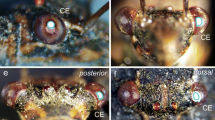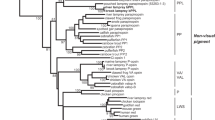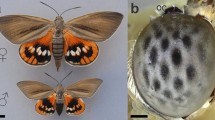Abstract
Lepidopterans display biological rhythms associated with egg laying, eclosion and flight activity but the photoreceptors that mediate these behavioural patterns are largely unknown. To further our progress in identifying candidate light-input channels for the lepidopteran circadian system, we have developed polyclonal antibodies against ultraviolet (UV)-, blue- and extraretinal long-wavelength (LW)-sensitive opsins and examined opsin immunoreactivity in the adult optic lobes of four hawkmoths, Manduca sexta, Acherontia atropos, Agrius convolvuli and Hippotion celerio. Outside the retina, UV and blue opsin protein expression is restricted to the adult stemmata, with no apparent expression elsewhere in the brain. Melatonin, which is known to have a seasonal influence on reproduction and behaviour, is expressed with opsins in adult stemmata together with visual arrestin and chaoptin. By contrast, the LW opsin protein is not expressed in the retina or stemmata but rather exhibits a distinct and widespread distribution in dorsal and ventral neurons of the optic lobes. The lamina, medulla, lobula and lobula plate, accessory medulla and adjacent neurons innervating this structure also exhibit strong LW opsin immunoreactivity. Together with the adult stemmata, these neurons appear to be functional photoreceptors, as visual arrestin, chaoptin and melatonin are also co-expressed with LW opsin. These findings are the first to suggest a role for three spectrally distinct classes of opsin in the extraretinal detection of changes in ambient light and to show melatonin-mediated neuroendocrine output in the entrainment of sphingid moth circadian and/or photoperiodic rhythms.









Similar content being viewed by others
References
Bellingham J, Foster RG (2002) Opsins and mammalian photoentrainment. Cell Tissue Res 309:57–71
Bennett RR, Brown PK (1985) Properties of the visual pigments of the moth Manduca sexta and the effects of two detergents, digitonin and chaps. Vis Res 25:1771–1781
Bentrop J, Schillo M, Gerdon G, Draslar K, Paulsen R (2001) UV-light-dependent binding of a visual arrestin 1 isoform to photoreceptor membranes in a neuropteran (Ascalaphus) compound eye. FEBS Lett 493:112–116
Briscoe AD (1998) Molecular diversity of visual pigments in the butterfly Papilio glaucus. Naturwissenschaften 85:33–35
Briscoe AD (2000) Six opsins from the butterfly Papilio glaucus: molecular phylogenetic evidence for paralogous origins of red-sensitive visual pigments in insects. J Mol Evol 51:110–121
Briscoe AD, White RH (2005) Adult stemmata of the butterfly Vanessa cardui express UV and green opsin mRNAs. Cell Tissue Res 319:175–179
Briscoe AD, Bernard GD, Szeto AS, Nagy LM, White RH (2003) Not all butterfly eyes are created equal: rhodopsin absorption spectra, molecular identification, and localization of ultraviolet-, blue-, and green-sensitive rhodopsin-encoding mRNAs in the retina of Vanessa cardui.J Comp Neurol 458:334–349
Callebert J, Jaunay JM, Jallon JM (1991) Control of Drosophila biorhythms. Adv Pineal Res 5:81–84
Chou W-H, Hall KJ, Wilson DB, Wideman CL, Townson SM, Chadwell LV, Britt SG (1996) Identification of a novel Drosophila opsin reveals specific patterning of the R7 and R8 photoreceptor cells. Neuron 17:1101–1115
Cowman AF, Zuker CS, Rubin GM (1986) An opsin gene expressed in only one photoreceptor cell type of the Drosophila eye. Cell 44:705–710
Cymborowski B, Korf H-W (1995) Immunocytochemical demonstration of S-antigen (arrestin) in the brain of the blowfly Calliphora vicina. Cell Tissue Res 279:109–114
Dolph PJ, Ranganathan R, Colley NJ, Hardy RW, Socolich M, Zuker CS (1993) Arrestin function in inactivation of G protein-coupled receptor rhodopsin in vivo. Science 260:1910–1916
Felisberti F, Ventura DF (1996) Cerebral extraocular photoreceptors in ants. Tissue Cell 28:25–30
Felisberti F, Ventura DF, Hertel H (1997) Cerebral extraocular photoreceptors in beetles. Comp Biochem Physiol 118A:1353–1357
Fleissner G (1982) Isolation of an insect circadian clock. J Comp Physiol 149:311–316
Fleissner G, Fleissner G (2003) Nonvisual photoreceptors in arthropods with emphasis on their putative role as receptors of natural Zeitgeber stimuli. Chronobiol Int 20:593–616
Fleissner G, Fleissner G, Frisch B (1993) A new type of putative non-visual photoreceptors in the optic lobe of beetles. Cell Tissue Res 273:435–445
Froy O, Gotter AL, Caselman AL, Reppert SM (2003) Illuminating the circadian clock in monarch butterfly migration. Science 300:1303–1305
Gao N, Schantz M von, Foster RG, Hardie J (1999) The putative brain photoperiodic photoreceptors in the vetch aphid, Megoura viciae. J Insect Physiol 45:1011–1019
Gilbert C (1994) Form and function of stemmata in larvae of holometabolous insects. Annu Rev Entomol 39:323–349
Hagberg M (1986) Ultrastructure and central projections of extraocular photoreceptors in caddiesflies (Insecta: Trichoptera). Cell Tissue Res 245:643–648
Hardeland R (1997) New actions of melatonin and their relevance to biometeorology. Int J Biometeorol 41:47–57
Hariyama T (2000) The brain as a photoreceptor: intracerebral ocelli in the firefly. Naturwissenschaften 87:327–330
Helfrich-Förster C, Stengl M, Homberg U (1998) Organization of the circadian system in insects. Chronobiol Int 15:567–594
Helfrich-Förster C, Edwards T, Yasuyama K, Wisotzki B, Schneuwly S, Stanewsky R, Meinertzhagen IA, Hofbauer A (2002) The extraretinal eyelet of Drosophila: development, ultrastructure, and putative circadian function. J Neurosci 22:9255–9266
Hintermann E, Grieder NC, Amherd R, Brodbeck D, Meyer UA (1996) Cloning of an arylalkylamine N-acetyltransferase (aaNAT1) from Drosophila melanogaster expressed in the nervous system and the gut. Proc Natl Acad Sci USA 93:12315–12320
Hodková M (1989) Indication of the role of melatonin in the regulation of reproduction in Pyrrhocoris apterus (Heteroptera). Acta Entomol Bohemoslov 86:81–85
Hofbauer A, Buchner E (1989) Does Drosophila have seven eyes? Naturwissenschaften 76:335–336
Homberg U, Hildebrand JG (1989) Serotonin immunoreactivity in the optic lobes of the sphinx moth Manduca sexta and colocalization with FMRFamide and SCPB immunoreactivity. J Comp Neurol 288:243–253
Homberg U, Würden S (1997) Movement-sensitive, polarization-sensitive, and light-sensitive neurons in the medulla and accessory medulla of the locust, Schistocerca gregaria. J Comp Neurol 386:329–346
Huber A, Schulz S, Bentrop J, Groell C, Wolfrum U, Paulsen R (1997) Molecular cloning of Drosophila Rh6 rhodopsin: the visual pigment of a subset of R8 photoreceptor cells. FEBS Lett 406:6–10
Ichikawa T (1991) Brain photoreceptors in the pupal and adult butterfly: fate of the larval ocelli. Zool Sci 8:471–476
Ichikawa T (1994) Reorganization of visual interneurons during metamorphosis in the swallowtail butterfly Papilio xuthus. J Comp Neurol 340:185–193
Ichikawa T, Tateda H (1982) Distribution of color receptors in the larval eyes of four species of Lepidoptera. J Comp Physiol 149:317–324
Kitamoto J, Ozaki K, Arikawa K (2000) Ultraviolet and violet receptors express identical mRNA encoding an ultraviolet-absorbing opsin: identification and histological localization of two mRNAs encoding short-wavelength-absorbing opsins in the retina of the butterfly Papilio xuthus. J Exp Biol 203:2887–2894
L’Hélias C, Callebert J, Beaudry P, Launay JM (1995) N-acetyl transferase activity during the photoperiodic-dependent Pieris brassicae development. J Insect Physiol 41:827–835
Li S-N, Chang Y-Z (1991) Ultrastructure of the larval stemmata, the stemmata nerves and the optic neuropils of the larval cotton bollworm, Heliothis armigera (Hübner) (Lepidoptera: Noctuidae). Int J Insect Morphol Embryol 20:1–13
Lieb WE, Smith-Lang L, Dua HS, Christensen AC, Donoso LA (1991) Identification of a S-antigen-like molecule in Drosophila melanogaster: an immunohistochemical study. Exp Eye Res 53:171–178
Loesel R, Homberg U (2001) Anatomy and physiology of neurons with processes in the accessory medulla of the cockroach Leucophaea maderae. J Comp Neurol 439:193–207
Malpel S, Klarsfeld A, Rouyer F (2002) Larval optic nerve and adult extra-retinal photoreceptors sequentially associate with clock neurons during Drosophila brain development. Development 129:1443–1453
Marchalonis JJ, Adelman MK, Robey IF, Schluter SF, Edmundson AB (2001) Exquisite specificity and peptide epitope recognition promiscuity, properties shared by antibodies from sharks to humans. J Mol Recognit 14:110–121
Melzer RR, Paulus HF (1989) Evolutionswege zum Larvalauge der Insekten - Die Stemmata der höheren Dipteren und ihre Abwandlung zum Bolwig-Organ. Z Zool Syst Evolforsch 27:200–245
Montell C, Jones K, Zuker C, Rubin G (1987) A second opsin gene expressed in the ultraviolet-sensitive R7 photoreceptor cells of Drosophila melanogaster. J Neurosci 7:1558–1566
Mouritsen H, Frost BJ (2002) Virtual migration in tethered flying monarch butterflies reveals their orientation mechanisms. Proc Natl Acad Sci USA 99:10162–10166
Nässel DR (1987) Aspects of the functional and chemical anatomy of the insect brain. In: Ali MA (Ed) Nervous systems of invertebrates. Plenum, New York, pp 353–392
Niva CC, Takeda M (2003) Effects of photoperiod, temperature and melatonin on nymphal development, polyphenism and reproduction in Halyomorpha halys (Heteroptera: Pentatomidae). Zool Sci 20:963–970
Numata H, Shiga S, Morita A (1997) Photoperiodic receptors in arthropods. Zool Sci 14:187–197
Papatsenko D, Sheng G, Desplan C (1997) A new rhodopsin in R8 photoreceptors of Drosophila: evidence for coordinate expression with Rh3 in R7 cells.Development 124:1665–1673
Paulus HF (2000) Phylogeny of the Myriapoda-Crustacea-Insecta: a new attempt using photoreceptor structure. J Zool Syst Evol Res 38:189–208
Paulus HF, Schmidt M (1978) Evolutionswege zum Larvalauge der Insekten: Die Stemmata der Trichoptera und Lepidoptera. Z Zool Syst Evolforsch 16:188–216
Pollock JA, Benzer S (1988) Transcript localization of four opsin genes in the three visual organs of Drosophila: RH2 is ocellus specific. Nature 333:779–782
Reischig T, Stengl M (2003) Ectopic transplantation of the accessory medulla restores circadian locomotor rhythms in arrhythmic cockroach (Leucophaea maderae). J Exp Biol 206:1877–1886
Richter K, Peschke E, Peschke D (2000) A neuroendocrine releasing effect of melatonin in the brain of an insect, Periplaneta americana (L.). J Pineal Res 28:129–135
Riddiford LM, Johnson LK (1971) Synchronization of hatching of Antheraea pernyi. Proc XIIIth International Congress Entomology, vol 1, Moscow 1968, p 431
Rieger D, Stanewsky R, Helfrich-Förster C (2003) Cryptochrome, compound eyes, Hofbauer-Buchner eyelets, and ocelli play different roles in the entrainment and masking pathway of the locomotor activity rhythm in the fruit fly Drosophila melanogaster. J Biol Rhythms 18:377–391
Roenneberg T, Foster RG (1997) Twilight times: light and the circadian system. Photochem Photobiol 66:549–561
Sauman I, Reppert SM (1996) Circadian clock neurons in the silkmoth Antheraea pernyi: novel mechanisms of Period protein regulation. Neuron 17:979–990
Saunders DS (2002) Insect clocks, 3rd edn. Elsevier, Amsterdam
Schulz W-D, Schlüter U, Seifert G (1984) Extraocular photoreceptors in the brain of Epilachna varivestis (Coleoptera, Coccinellidae). Cell Tissue Res 236:317–320
Schwemer J, Paulsen R (1973) Three visual pigments in Deilephila elpenor (Lepidoptera, Sphingidae). J Comp Physiol 86:215–229
Seifert P, Smola U, Schinko I (1987) Internal extraocular photoreceptors in a dipteran insect. Tissue Cell 19:111–118
Shiga S, Davis NT, Hildebrand JG (2003) Role of neurosecretory cells in the photoperiodic induction of pupal diapause of the tobacco hornworm Manduca sexta. J Comp Neurol 462:275–285
Shimizu I, Yamakawa Y, Shimazaki Y, Iwasa T (2001) Molecular cloning of Bombyx cerebral opsin (Boceropsin) and cellular localization of its expression in the silkworm brain. Biochem Biophys Res Commun 287:27–34
Swinderen B van, Hall JC (1995) Analysis of conditioned courtship in dusky-andante rhythm mutants of Drosophila. Learn Mem 2:49–61
Takeda M, Endo Y, Saito H, Nishiitsutsuji-Uwo J (1988) Immunohistochemical search for the structure of the circadian system in Periplaneta americana. In: Sehnal F, Zabźa A, Denlinger DL (eds) Endocrinological frontiers in physiological insect ecology. Wroclaw Technical University Press, Wroclaw, pp 791–806
Takeda M, Endo Y, Ohnishi H, Ichihara N (1999) Photoperiodic system in physiological reality. Entomol Sci 2:567–574
Truman JW (1972) Physiology of insect rhythms. II. The silkmoth brain as the location of the biological clock controlling eclosion. J Comp Physiol 81:99–114
Truman JW, Riddiford LM (1970) Neuroendocrine control of ecdysis in silkmoths. Science 167:1624–1626
Tyrer NM, Shepherd D, Williams DW (2000) Methods for imaging labelled neurons together with neuropil features in Drosophila. J Histochem Cytochem 48:1575–1581
Vivien-Roels B, Pévet P (1993) Melatonin: presence and formation in invertebrates. Experientia 49:642–647
Vivien-Roels B, Pévet P, Beck O, Fevre-Montange M (1984) Identification of melatonin in the compound eyes of an insect, the locust (Locusta migratoria), by radioimmuno-assay and gas chromatography-mass spectrometry. Neurosci Lett 49:153–157
Wellington WG, Sullivan GR, Green GW (1957) Polarized light and body temperature level as orientation factors in the light reaction of some hymenopterous and lepidopterous larvae. Can J Zool 29:339–351
White RH (1968) The effect of light and light deprivation upon the ultrastructure of the larval mosquito eye. III. Multivescicular bodies and protein uptake. J Exp Zool 169:261–278
White RH, Xu H, Münch TA, Bennett RR, Grable EA (2003) The retina of Manduca sexta: rhodopsin expression, the mosaic of green-, blue- and UV-sensitive photoreceptors, and regional specialization. J Exp Biol 206:3337–3348
Wise S, Davis NT, Tyndale E, Noveral J, Folwell MG, Bedian V, Emery IF, Siwicki KK (2002) Neuroanatomical studies of period gene expression in the hawkmoth, Manduca sexta. J Comp Neurol 447:366–380
Yamano H, Watari Y, Arai, T, Takeda M (2001) Melatonin in drinking water influences a circadian rhythm of locomotor activity in the house cricket, Acheta domesticus. J Insect Physiol 47:943–949
Yasuyama K, Meinertzhagen IA (1999) Extraretinal photoreceptors at the compound eye’s posterior margin in Drosophila melanogaster. J Comp Neurol 412:193–202
Zipursky SL, Venkatesh TR, Teplow DB, Benzer S (1984) Neuronal development in the Drosophila retina: monoclonal antibodies as molecular probes. Cell 36:15–26
Zordan M, Osterwalder N, Rosato E, Costa R (2001) Extra ocular photic entrainment in Drosophila melanogaster. J Neurogenet 15:97–116
Zuker CS, Montell C, Jones K, Laverty T, Rubin GM (1987) A rhodopsin gene expressed in photoreceptor cell R7 of the Drosophila eye: homologies with other signal transduction molecules. J Neurosci 7:1550–1557
Acknowledgements
We are grateful to Dr. Larry A. Donoso for the generous gift of a set of arrestin antibodies and peptides, to Dr. Joachim Schachtner for his gift of eggs of Manduca sexta, to Dr. Carol Gregorio for help with the antibody immunoaffinity purification and to Dr. Lisa Nagy for sponsoring us while the antibodies were being made. We also thank Angela Bruns and Claudia Obermeier for excellent rearing of our hawkmoth stocks. The monoclonal antibody 24B10 developed by Seymour Benzer was obtained from the Developmental Studies Hybridoma Bank developed under the auspices of the NICHD and maintained by the Department of Biological Sciences, University of Iowa, Iowa City, USA.
Author information
Authors and Affiliations
Corresponding author
Additional information
This work was partially supported by the Canadian Institute for Advanced Research (A.D.B.) and the National Science Foundation (grant nos. IBN-0082700 and IBN-0346765; A.D.B.).
Rights and permissions
About this article
Cite this article
Lampel, J., Briscoe, A.D. & Wasserthal, L.T. Expression of UV-, blue-, long-wavelength-sensitive opsins and melatonin in extraretinal photoreceptors of the optic lobes of hawkmoths. Cell Tissue Res 321, 443–458 (2005). https://doi.org/10.1007/s00441-004-1069-1
Received:
Accepted:
Published:
Issue Date:
DOI: https://doi.org/10.1007/s00441-004-1069-1




